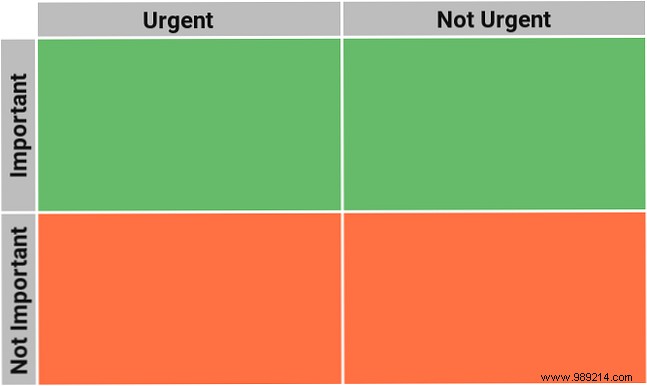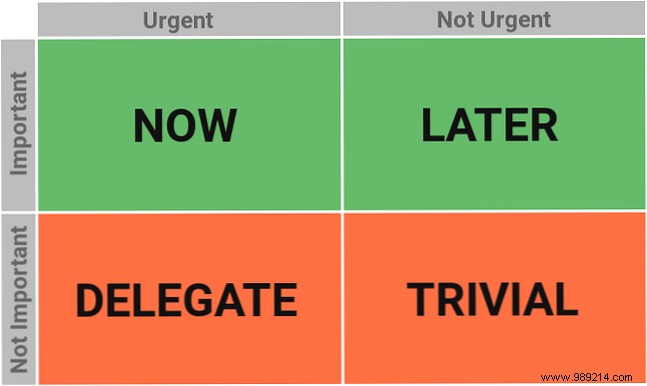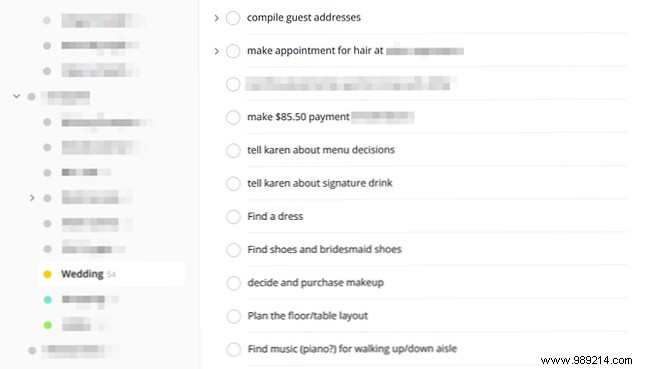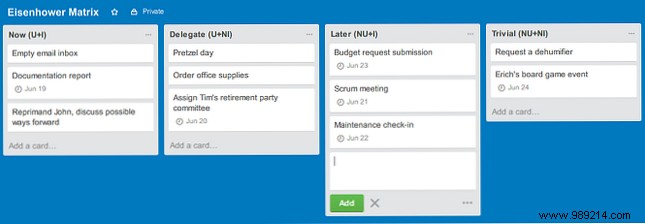To-do list apps are all the rage these days. Science has shown that lists really do boost productivity, and you can boost productivity with tricks like making your to-do list public. Some people even use their email inboxes as to-do lists.
But what if you've tried all that and none of it works?
Lucky For You, Alternative Productivity Methods 5 New Productivity Techniques You Probably Haven't Heard Of 5 New Productivity Techniques You Probably Haven't Heard Of If you're still looking for the best way to increase your productivity, try one of these best alternatives to Pomodoro and GTD . Remember to stop searching once you've found a "good enough" solution. Read More And if you find the usual to-do lists too annoying or too overwhelming, we recommend trying an old but effective technique called the Eisenhower Matrix. .
The Eisenhower matrix is a 2 × 2 grid of boxes. The top row is for tasks that are “Important” while the bottom row is for tasks that are “Not Important.” At the same time, the left column is for tasks that are “Urgent” while the right row is for tasks that are “Non-urgent.” This is what it looks like:

For most people, the terms Important and Urgent are synonymous, so let's take a moment to define the difference between them:
Before you can decide whether or not a task is important, you need to know your own goals and values. For many, career progression is a long-term goal, so tasks directly related to that are important. Or if you value family more, then getting home on time may be important.
But how can a task be urgent but not important? Remember that the urgency is only it was time. Think about the deadline. Let's say today is International Coffee Day and your local coffee shop is offering free coffees. If you don't take advantage of this today, the opportunity is lost, but free coffee has no relevance to your long-term goals or values. It is urgent, but not important..
Using these definitions, it is easier to describe the types of tasks that fall into each of the four boxes. We can even think of the array this way:

The Eisenhower Matrix is simply a way to prioritize your tasks .
To-do lists are great for tracking. what You have to, but it's not always easy to determine which Tasks have higher priority. I've personally never used the "Priority" function in any to-do list app because I always end up labeling everything as "High Priority" - and when everything is high priority, nothing is.
Also, when you look at a to-do list and see 30 tasks piling up, how do you decide which task to tackle? "Start with the easiest," some say. “No, start with the most difficult,” others say. But what is easy and what is difficult? It is never black and white. Many times, I have wasted 10, 15 or even 30 minutes trying to choose my homework!

This is why the Eisenhower Matrix shines.. Unlike a single to-do list, the matrix is self-prioritizing. It tells you which one task to handle next. It decreases the cognitive load because only the Now and Later boxes are really important. And if you ever have time, it helps you see which tasks you can skip.
In addition, the matrix has two other minor benefits. First, it forces you to be more aware of each task. Instead of throwing everything into a big to-do pile, you actively decide if tasks are worth your time at first, keeping your to-do list tight. Second, it constantly reminds you of your goals and values.
The only problem is that the Eisenhower matrix can be a bit tricky at first. In particular, new users tend to be misled by the Delegate and Trivial boxes. There it a learning curve, so let's look at a practical example of how to set up a matrix, organize tasks, and get through a day.
Although the Eisenhower Matrix is conceptually a four-box square, it can practically be thought of as four separate to-do lists:a now list, a delegate list, an after list, and a trivial list. The two urgent lists come before the non-urgent lists.
I find Trello amazing for this. Set up a chart for each area of your life (eg personal, professional, church, hobby) and set these four lists on each of the charts. Or if you don't have many activities, you can use one table for all tasks. Up to you. You don't like Trello? Consider these alternative Kanban tools. Goodbye Trello! 5 Free Kanban Board Tools Goodbye, Trello! 5 Free Alternative Kanban Board Tools Trello is an amazing app for managing projects and organizing your tasks. But there are other kanban apps that could be ideal for your tasks. Let's talk about the best Trello alternatives. Read more.
Once your lists are ready, you can start adding tasks:

Let's say you're a traditional office worker who wants to use the Eisenhower Matrix to be more productive at work. This will be the scenario that drives the rest of this example, but it should be easy to apply these concepts otherwise.
What's on your plate for today? The first thing that comes to mind:email. Let's create a task to get to inbox zero, which is both urgent (email needs to be emptied daily) and important (we're talking about work-related emails here):

Today happens to be Pretzel Day at the office and you're craving a free pretzel with the works. This may be urgent, but it's not important:

Your boss reminds you that the documentation report for your team's latest project is due by 4 PM, which is urgent and important:

He also reminds you that your team's RFQ for your next project is due by the end of the day on Friday. This is important, but not urgent:

The office manager walks up to you and tells you that the paper and ink supplies are running low. You should place an order as soon as possible, but this has little to do with your professional goals or values:

It's early summer (in this scenario) and the office is getting too humid with the rainy season. Everyone's productivity would skyrocket with a good dehumidifier, not to mention all the other benefits of reducing humidity household household products? It's okay. One or two smart purchases could drastically improve your quality of life at home. Read more.
Make a note to mention this, but it's not urgent or important:

And so it goes on and on. Meetings come up, planning needs to be done, remember things you want to do, etc. Eventually, your matrix (i.e. lists) will fill up, and the best part is that it's much less intimidating than a master to-do list:

When you're free for another task, just start on the left and move to the right. You should address everything on the Now and Delegate lists before you address the non-urgent lists.
If you can delegate, tackle the delegate list first, and offload as many tasks as you can. Then go through the list now. Once you get through the Now list, consider your day a success. You can now get a head start on the Later list or finish the day early.
If your hypocrisy delegate, start the list now. If you go through the Now list and have more time, you have a choice:treat the Delegates list as a Now list, get a head start on the Later list, or finish the day early. In practice, you'll probably want to toggle between Delegating and Post Tasks.
At the end of the day, go to the list of delegates and discard all the tasks whose deadlines have passed. Save the ones you can still do. Save them for tomorrow.
At the beginning of the next day, go to the Later list and decide which tasks are urgent now. Change them to the list now. Do the same for the trivial list, except change those tasks to the delegate list. Add any new tasks that come up throughout the day. Rinse and repeat.
Note that you can modify the Eisenhower matrix as you wish. For example, instead of using it to guide your entire day, you can sort your email with your own matrix. This is the most decisive email classification solution you will ever need. This is the most decisive email classification solution you will ever need. you are always on top of your emails. You only need four labels or folders to manage your inbox and reduce your email stress. Read more . The whole concept of urgency/importance can come in handy in all kinds of cases beyond work and email.
Many people have had great success with the Eisenhower Matrix. But if you've gotten to this point and don't think it will help, that's fine. Keep looking for the method that works for you. When all is said and done, the only productivity technique that matters The best productivity tool is the one you actually use The best productivity tool is the one you actually use In a productivity-seeking world, every shiny new productivity app promises something new. But are we missing something when we change our productivity apps too often? Read More
Do you find the Eisenhower matrix useful? If not, what productivity technique do you use to stay organized and on track? Share with us in the comments below!